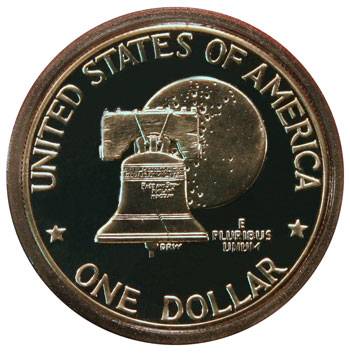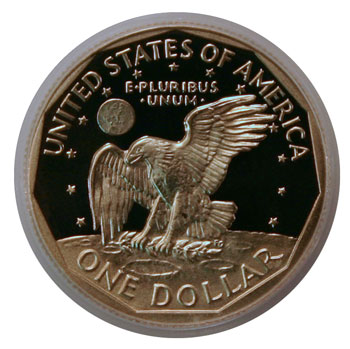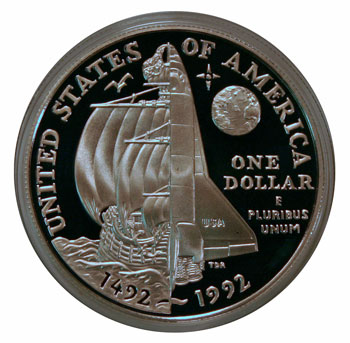Fifty years ago on May 5, 1961, Alan Bartlett Shepard, Jr. became the first American in space aboard the Mercury Freedom 7 spacecraft. He and his spacecraft were launched by a Redstone vehicle and traveled to an altitude of 116 miles.
Later in the program, twelve astronauts traveled to the moon for a short walk along the gray surface among the craters. After being the first American in space, Alan Shepard got to be the fifth person to walk on the moon.
Through the years, the US Mint has referenced the moon and the nation’s exploration of it in several coins. In particular, let’s look at four of them – three intended for pocket change and one commemorative silver dollar.
First is the Eisenhower dollar introduced in 1971. This coin’s reverse shows an eagle dipping down to retrieve an olive branch from the moon’s surface. In the distant background, a small earth shows over the eagle’s right shoulder. Chief Engraver Frank Gasparro adapted the logo for the Apollo 11 mission for the reverse of the Eisenhower dollar.
This dollar was the same diameter of the early silver dollars at 38.1 mm or 1.5 inches. The version for general circulation was made of cupronickel alloy and weighed 22.68 grams. But a collectible version was made of 40% silver and weighed 24.59 grams.
To celebrate the nation’s 200th anniversary, the US Mint held a competition for bicentennial images for the quarter, half dollar and dollar. The winning entry for the dollar contained a liberty bell and moon image by Dennis R. Williams.
This dollar was produced in 1975 and 1976 in cupronickel alloy for general circulation and in 40% silver for collectible coinage.
In 1977 and 1978, the US Mint returned to the eagle landing on the moon for the reverse of the Eisenhower dollar. But, both circulating and collectible dollars at this point consisted of the cupronickel alloy. (Unless you were lucky enough to obtain one of the 1977D made in error of the 40% silver clad.)
In 1979, a new, smaller dollar was introduced to save the Mint and the taxpayers a lot of money. People were going to use these dollars which would last roughly 15 years rather than the paper dollar which needed to be replaced every 18 months or so.
This new dollar carried the first portrait of a real, though deceased, woman’s image on the obverse and a slightly modified version of the eagle on the moon on the reverse.
This dollar, which was not accepted by the American public as government officials had wanted it to be, was slightly larger than a quarter and the same color as it, too, was made of the cupronickel alloy.
Moving on a few years to 1992, the US Mint produced coins commemorating the Quincentenary (500th year) anniversary of Columbus arriving at the New World. Though three coins were made, a cupronickel half dollar, a 90% silver dollar and a gold $5 coin, the silver dollar recognized the exploration to find the New World and to explore space.
The US Mint’s sculptor, Thomas D. Rogers, designed a split image of the Santa Maria ship on the left and the US space shuttle Discovery on the right. This coin uses the same specifications as the early silver dollars in size, weight and silver content.
These coins give us an opportunity to recognize and remember the exploration efforts into space and on the moon.



